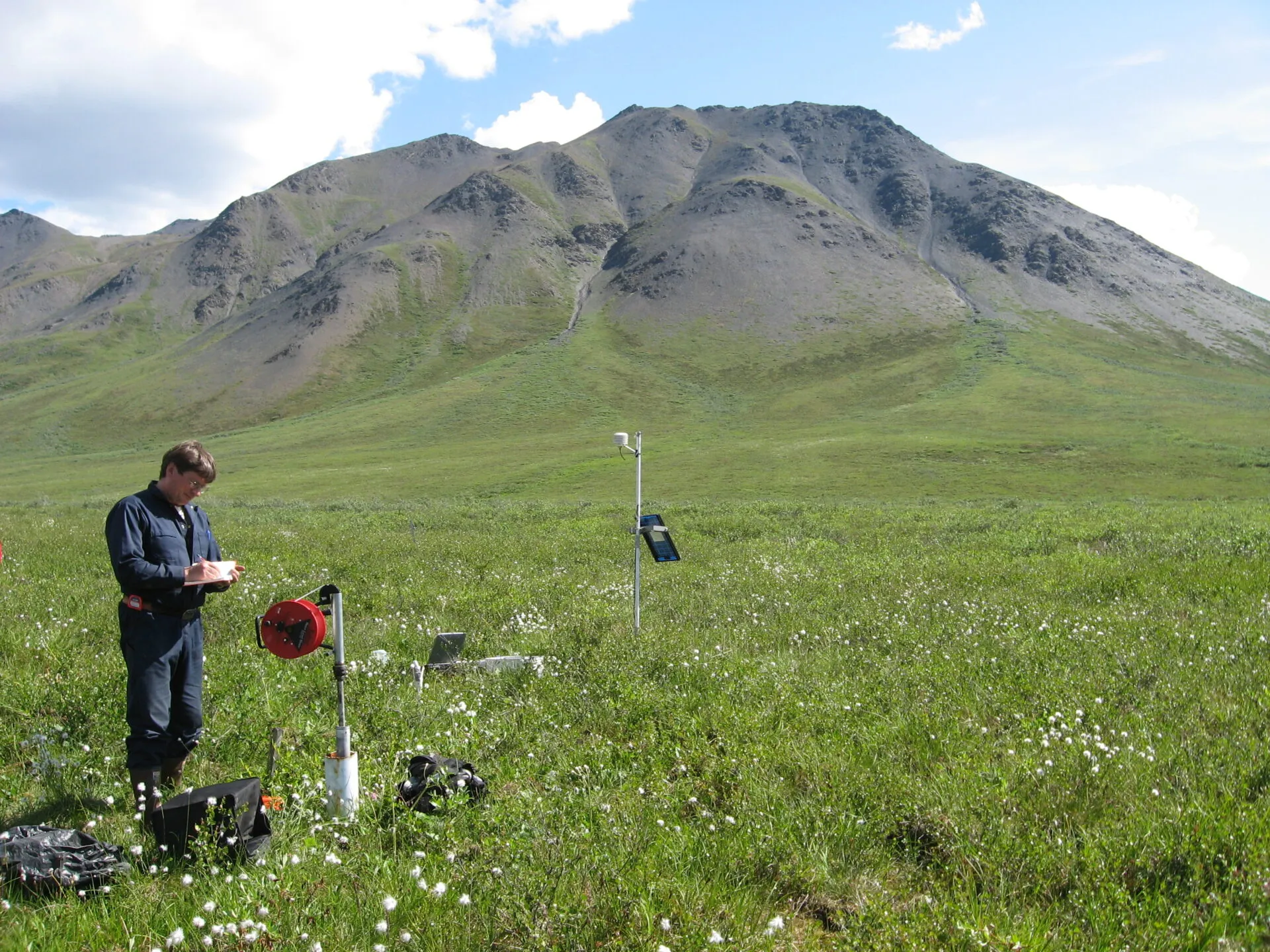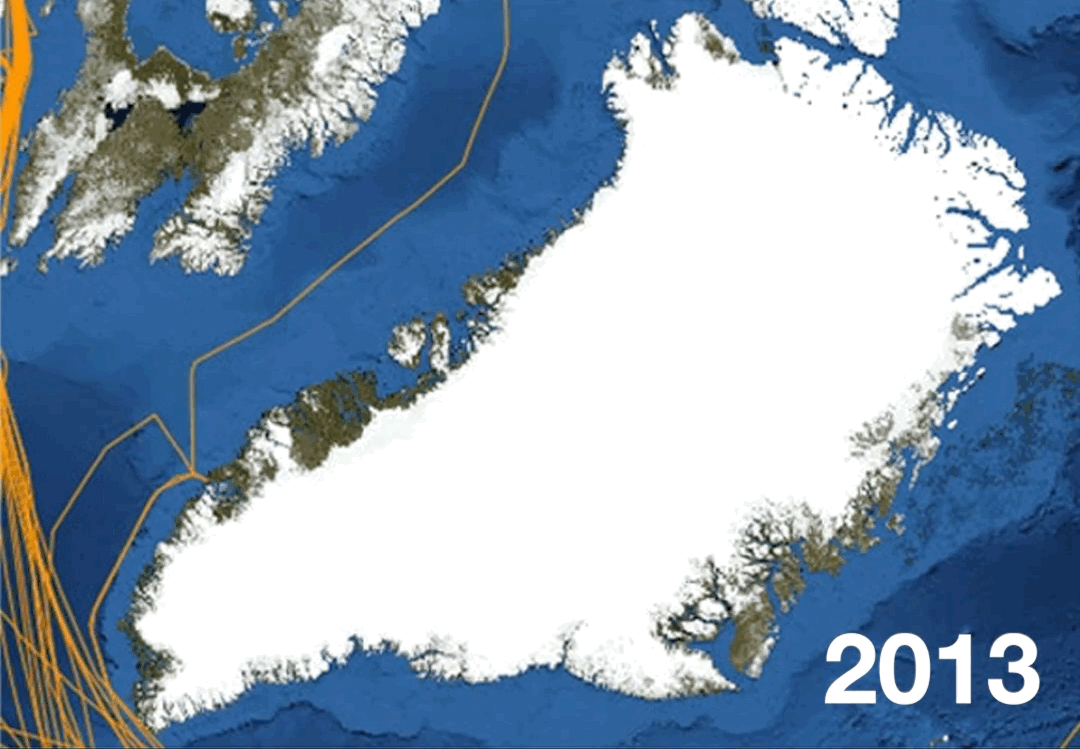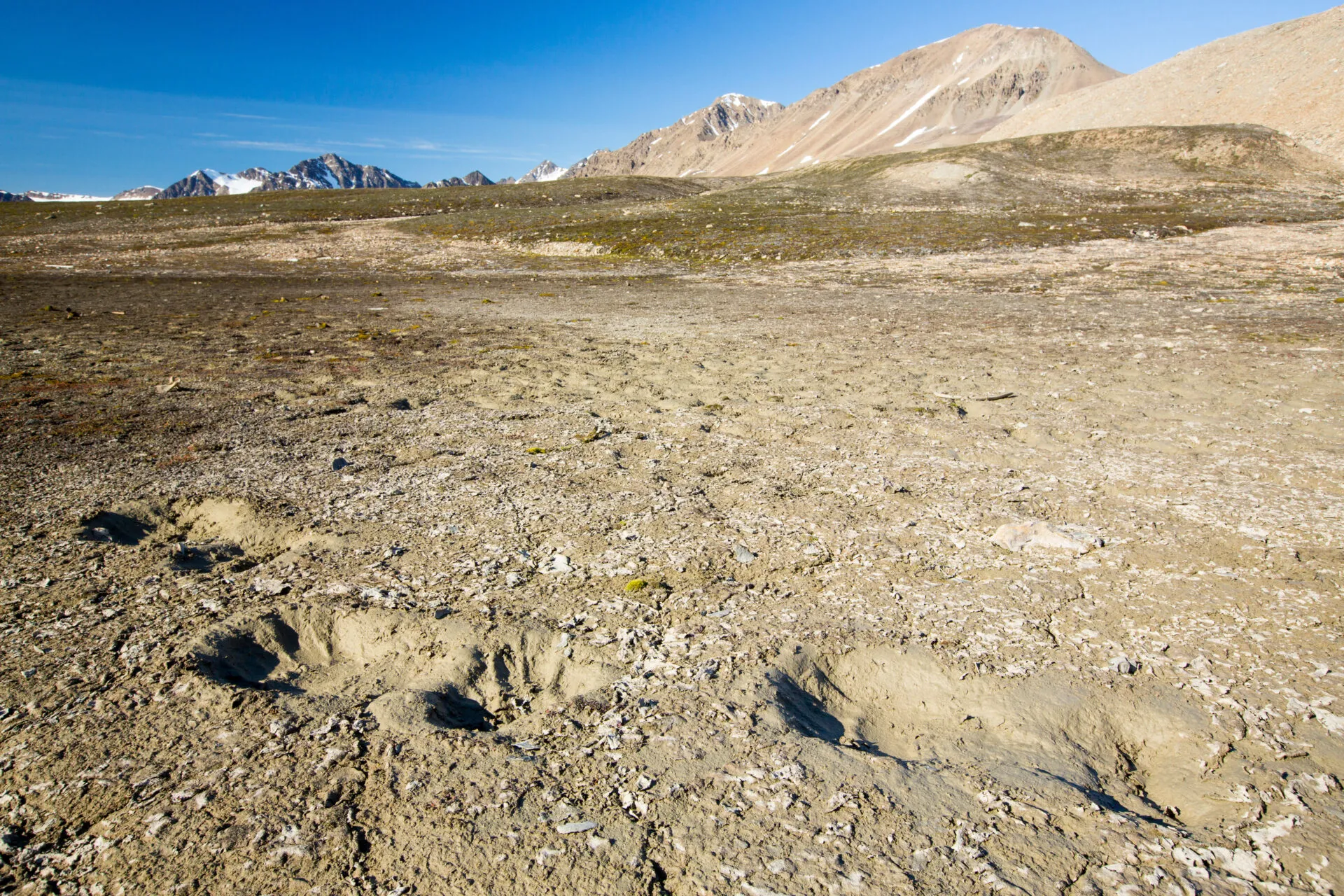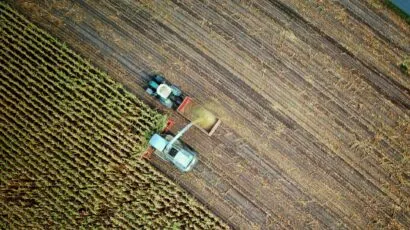A rising danger in the Arctic
As climate change melts permafrost, microbes will emerge. The world isn’t paying enough attention to the potential threat they pose.
Sunset on the Arctic horizon as captured in the Chukchi Sea during NASA’s 2011 study on Impacts of Climate on Ecosystems and Chemistry of the Arctic Pacific Environment. Melt ponds like these that form on sea ice and permafrost are fast developing their own new microbiomes. NASA/Kathryn Hansen
The popular image of the Arctic is as a “frozen North,” which it was for all of human history until a couple of centuries ago. In that view, intrepid explorers and scientists clatter over tundra and ice roads in dogsleds and decrepit trucks, risking everything to bring back important samples and wild tales of howling winds. But this vision is growing passé. The Arctic is warming four times as fast as the global average. While there are still plenty of extreme risks from sea ice, blizzards, and the like, from here on it will be the dangers of thawing, not freezing, that plague the Arctic. The problems people encounter will involve mosquitoes, mud, cracked roadways, flooding, buildings splitting down the middle—and disease.
Vladimir Romanovsky had an experience typical of the new Arctic. An emeritus geophysicist at the Permafrost Laboratory at the University of Alaska Fairbanks, he studies the thermodynamics of permafrost. On a field trip recently near Alaska’s Prudhoe Bay, where the permafrost is still mostly frozen but has a deepening liquid top layer, he made a classic error on the way to a site where he wanted to take measurements. “I knew I shouldn’t go there, but it was a good shortcut to the place where I should go,” he says. His boots got stuck not in quicksand, but in a new type of pitfall he calls “siltsand”—many times more viscous and adhesive than waterlogged sand.
It was not a heroic life-or-death moment—it was a comic pulling of bootstraps as he balanced on one leg while yanking first one boot, then the other, out of a deceptively smooth and shallow surface. Falling would have meant losing his boots and crawling through the siltsand to the pond’s edge. His field partner was half an hour away.
Romanovsky’s experience was benign, but it illustrates how people are meeting new ecosystems with unaccustomed risks. He didn’t have to fight off germs afterward, but melt ponds in permafrost are fast developing their own new microbiomes, and it is not clear how benign or malign they may become. The conditions that protected the Arctic from many health threats, both local and from the south, are melting away.

No organisms—except possibly microbes—are prepared to adapt to the unstable climate regime the Earth has entered. Humans are far behind the curve in adapting to the climate change they have caused with their carbon dioxide emissions, particularly as regards the climate-driven spread of pathogens. The tropics have been a focus of concern about climate and disease, as warming causes insects and other disease vectors to spread away from the equator. But while diseases from the south, such as dengue fever, Ebola, and Zika, are clear dangers that occupy most of the attention of infectious disease epidemiologists, few researchers are looking for new or ancient Arctic pathogens that current generations of humans have never been exposed to.
One research team described permafrost as “a reservoir of minimally characterized microbial life” that can hold thousands of species, very few of which have been studied. Because there is so little information, most experts caution that trying to assess the microbial risk in and from the Arctic is speculative. But others point out that when data is sparse, informed hypothesizing can lead to an improved strategy for responding to crises now unforeseen.
Recently there’s been a lot of press coverage of “zombie viruses” bursting out of thawing permafrost. The bodies of people and animals buried in permafrost a few centuries ago have contained potentially infectious variants of smallpox, anthrax, and influenza, but because of this risk, most scientists have expressed little interest in studying zombie viruses—especially smallpox—in a lab.
There is little agreement among experts as to the risks of “zombie” pathogens spreading into the larger world population. Some research establishes that even very old permafrost microbes can be viable.
But Paul Hunter, a professor of medicine at the University of East Anglia who has studied Covid and infectious diseases related to extreme weather, is not worried about the viruses that have actually been revived from permafrost because “none of them are human pathogens, they’re all protozoan viruses.” Further, Hunter says, because all the “zombie viruses” that are human pathogens are familiar, if they are revived they can be handled with vaccines and antibiotics. “Currently there’s nothing to suggest there would be something coming out that would be a new disease that would infect humans,” he adds. Much of the viral DNA found in permafrost is degraded, so even if the viruses remain intact, they are unlikely to be infectious.
But zombies may be the least of our Arctic disease worries.
Arctic microbes are far more diverse and complex than the few familiar viruses identified so far in frozen bodies that have thawed, and they present very real risks to humans and other animals. Unlike Antarctica, the Arctic is home to millions of people (estimates range from four million to 13 million). Pathogens are moving both southward from and northward into Arctic regions through many routes, and people in the Arctic are bearing the brunt of them. Indigenous residents and mobile workers in mining and fossil fuel extraction industries face the most immediate risks from the mingling of previously separated ecologies. Climate change also promises to aggravate zoonosis, or diseases that jump from animals to people (and vice versa). Finally, there are risks from global atmospheric transport of microbes and from gene exchanges among formerly separated microbial populations that may create new diseases or worsen old ones.
The permafrost problem
Climate change has a clear and disturbing effect on infectious diseases. A 2022 study by University of Hawai’i ecologist Camilo Mora and colleagues found that of “375 infectious diseases documented to have impacted humanity, 218 were found to be aggravated by climatic hazards.” Warming, precipitation, floods, and drought exacerbated 103 vector-borne, 78 waterborne, and 60 airborne diseases, most caused by viruses and bacteria, with lesser involvement of fungi and protozoans. And these were only diseases already known to science.
Climate change is dramatically affecting permafrost, a loose conglomerate of rock, soil, plant matter, ice and microbes, with a thin top layer that melts and refreezes seasonally; it covers about 25 percent of the Northern Hemisphere’s land surface. Estimates of the oldest permafrost in the northern hemisphere, in Siberia’s Kolyma region, range between one million and three million years.
The combined mass of continuous permafrost in the Arctic and Tibetan Plateau is nearly 11 million square kilometers; by contrast, Antarctica’s permafrost covers at most about 71,000 km2. Russia is far and away the possessor of the most Arctic permafrost, a fact that causes problems for the rest of the world, given Russia’s war aims and unwillingness to share information.
Humans living in the Arctic have in recent centuries built their residences, businesses, and other infrastructure atop permafrost, which served as a sort of perpetual foundation. Now, as climate change proceeds, permafrost is collapsing across the North, destroying water systems, roads, buildings, and pipelines and leading to contamination of areas humans use. Permafrost collapse generates new lakes that can join up with surface streams and carry microbes into the ocean. Open-pit mines, eroded bluffs, and sinkholes expose ancient organic matter. In addition to bacteria and viruses, fungi, lichens, and even nematode worms have been revived from permafrost. So while there is some reason to avoid panic about zombie microbes, humans do face the possibility of meeting up with the vast, newly exposed microbial storehouse released from permafrost.
Potential pathogens could move into and out of the Arctic in multiple ways. Ships’ ballast water transports invasive species, including microbes. Animal carriers, especially rodents like beaver, rats and rabbits, bring southern pathogens like giardia, rabies, toxoplasmosis, and hantavirus northward, while marine mammals and birds migrate great distances north and south, traversing the Arctic, Pacific and Atlantic oceans distributing bacteria, viruses and fungi. And as resource extraction rises, more workers move between weeks-long shifts in the Arctic to urban areas in more southerly regions, often using air transport.
SPOTLIGHT
The outlier pathways for disease spread
All of the possible routes for emergence and spread of new pathogens are very likely to appear at the interface between ecosystems that have previously been isolated from each other—as we have learned from the bat-derived Covid and Ebola viruses. Climate change and development make fertile partners for rapid evolution of microbes because they create new interfaces. READ MORE...
Mora compared several centuries’ worth of climate change data with a dataset related to epidemics. He found that climate influences infectious diseases in several ways. “There has to be contact between disease and person,” he says. This happens where people are forced to migrate into new environments because of “hurricanes, floods, and heat waves.” Also, Mora found, pathogens can become stronger in higher latitudes where milder winters enable them to survive year-round and disasters degrade both public health protections and people’s immune responses in unaccustomed higher temperatures. All of these circumstances are starting to affect the Arctic.

Arctic shipping as a disease spreader
Increased shipping and accelerating development are closely tied in the Arctic and present a significant risk for disease spread. There is great interest in a trans-Arctic shipping route between the Atlantic and Pacific Oceans because it could shave five days off the current transit time through the Suez and Panama Canals for voyages between Asia, Europe, and eastern North America. Shipping interests eagerly anticipate the point when the trans-Arctic sea routes are ice-free year-round.
It's uncertain whether industrial and commercial development in the Arctic will continue apace in the short run. The Russia-Ukraine war has somewhat dampened enthusiasm for trans-Arctic shipping, as have the ongoing threat of sea ice blockages and problems maintaining land infrastructure crucial to both shipping and oil and gas exploration, including pipelines. But absent some reversal of climate warming or a global economic shock, shipping activity in the Arctic is expected to only go up. Over the last decade, Arctic shipping has certainly done so, as measured by overall ship traffic, distances sailed, and the striking example of the Mary River iron mine in Baffinland, where traffic in the nearby port of Milne Inlet jumped 583 percent in five years.

Ships move about 10 billion tons of ballast water around the world annually. Ships typically dump their ballast water, which helps maintain ship stability, in port and take in new water for the next journey. Expanded Arctic shipping brings with it a severe threat of microbe exchange between more southerly and Arctic waters. David Lodge, professor at Cornell’s Atkinson Center for Sustainability, has studied the explosion of invasive species in the world’s ports and coastlines. There is little data on the Arctic, so he stresses he is speculating, but says, “I think ships are the more likely way to bring quite novel organisms including microbes into the Arctic and out of the Arctic.”
The Russian city of Murmansk is the port with the highest risk of spreading invasive species, according to a 2016 paper by Notre Dame University computer scientist Mandana Saebi and colleagues. Most of the Murmansk traffic moves between Russian ports and those in Nordic countries. But many voyages also connect with ports to the south; for example, some voyages stopping at Murmansk also visit West African ports. This could exacerbate the spread of polar diseases southward and move tropical diseases into regions with expanding human presence that are rapidly losing permafrost and sea ice.
Tourist ships can also be a source of microbe exchange. The Arctic Council’s shipping survey found that the number of cruise ships in the Arctic jumped from 58 in 2013 to 96 in 2023, and cruise ships remain the sixth largest ship type behind fishing and cargo ships. One experiment found that antibiotic shoe wash placed where tourists moved on and off their ship did not effectively reduce their shoes’ microbial load. The passengers in the study visited the Svalbard archipelago, where concerns about microbial invasions affecting the terrestrial ecosystem are high.

Development, people, and disease transmission
Clearly, the more people move around, the higher the risk of disease transmission. In the Arctic, the most mobile population is likely the pool of extractive industry workers. A 2019 demographic atlas of the Arctic found that “the highest share of working-age population was in regions where a high proportion of employment is related to extracting natural resources, e.g. oil, gas and minerals. This is especially the case in the Russian Arctic regions.”
Some of these workers are residents, but industrial activity bringing in “non-resident male worker populations” is likely a pipeline for rapid dispersal of infectious diseases. According to a 2019 analysis from University College London, such transitory workers often live in “camp-like conditions” that encourage “increased demand for commercial sex and, thereby, potentially human trafficking.”
Because of the rapid travel patterns and cramped living quarters typical of extractive operations, “you don’t need a huge dispersal of a pathogen,” Mora says. You just need person-to-person transmission in close quarters and one infected person to carry the disease quickly to a more populated area.

Greenland is a prime example of the problem. It is already at high risk for pathogen exchange and on the brink of massive expansion of resource extraction. The mineral exploration company KoBold Metals, with investors who include Microsoft founder Bill Gates, Amazon and Washington Post owner Jeff Bezos, and Ray Dalio, founder of the world’s largest hedge fund, Bridgewater Associates, is exploring for nickel, copper, cobalt, and platinum group metals in Greenland as the island’s massive central ice sheet recedes. Their goal is ostensibly to facilitate the transition to a low-carbon economy. But, says Markus Kröger, professor of global development studies at the University of Helsinki, extraction projects are also pushing right up against the thawing permafrost and fostering the creation of boom-bust towns, which are known breeding grounds for both emerging and familiar diseases. Greenland is currently a hotspot for the sexually transmitted diseases chlamydia and gonorrhea, far outpacing the Arctic regions of the United States and Canada.
Neither KoBold Metals nor the Gates Foundation responded to multiple requests for comment on their Greenland efforts.

Animals and Arctic diseases
Along with shipping and development, there is a third major disease pipeline into and out of the world’s Arctic regions: zoonosis. Some 60 percent of known and 75 percent of emerging human pathogens have jumped from other animals to humans. In lower latitudes, bird flu has already jumped from birds to cattle and from cattle to humans. Cats and dogs have also been exposed. In the Arctic, domestic animals are already known to have exchanged pathogens with marine mammals.
Ashley Barratclough, a veterinarian with the National Marine Mammal Foundation in San Diego, studies disease transmission among Arctic mammals. She is concerned about Pacific orca, for example, traveling farther into the Arctic Ocean as waters warm to prey on bowhead whales. She says, “Climate change [is] opening up for the first time for these species to interact and [for their diseases to] cross over. That to me is a much bigger concern than the ice melting [and] releasing a pathogen from a dead body. We often refer to marine mammals as the sentinels of the ocean, and it’s a matter of time before they’re going to be affecting people.” The place to monitor the danger, she says, is among subsistence hunters and herders, who are the frontline humans at most risk from zoonosis. Herders are especially vulnerable in the Nordic Arctic and Russia’s vast permafrost region.
The wild unpredictability of zoonosis is one of the reasons it keeps many infectious disease experts up at night. A potential brake on it, says Barratclough, is that a pathogen—say, bird flu—jumping species may become “deadly in one species but not necessarily the other.” For example, she adds, “Influenza can be highly pathogenic in birds but not necessarily in marine mammals.” This also might be true for humans but is not certain and cannot be taken for granted for all diseases.

The microbe-spreading effects of wildfire
Wildfires are a major source of atmospheric particulates, and they are sharply increasing in size and ferocity globally. Climate change will amplify the Arctic’s contribution to this phenomenon. Romanovsky, the Alaska-based geophysicist, says wildfires can easily rage on top of permafrost. In a 2013 study he and his colleagues observed that wildfires can accelerate warming and irreversibly degrade permafrost. This causes something of a feedback loop that will catapult more material into the atmosphere.
Somewhat counterintuitively, wildfires are efficient microbe transporters. Bacteria are not necessarily killed by fires, and they even survive the updrafts of hot air surrounding wildfires. Viruses (not technically alive) also hitch rides. Anna Bruhn’s master’s thesis in geography from Sweden’s Lund University examined whether ancient microbes emerging from permafrost and ice might move between Greenland and continental Europe via the atmosphere. Greenland is still mostly ice, but it has seen numerous wildfires in the last 15 years. These have exploded in rapidly degrading permafrost, according to a study by Romanovsky.
Bruhn was surprised by her conclusion that microbes easily travel in wildfire smoke. “I didn’t think it would be so real-world applicable, because I thought if these diseases are going to emerge, they’re more likely to spread on a plane to Copenhagen,” she says.
What is being and should be done
There are national and international efforts to anticipate and control infectious diseases in the Arctic. Marion Koopmans, a veterinary virologist at The Netherlands’ Versatile Emerging Infectious Disease Observatory who has worked extensively on COVID-19 epidemiology, says, “Since the pandemic there was a big scale-up of the ability to test in all sorts of places in the world, and there’s now initiative to see how we can use that capacity for other things.”
The World Health Organization (WHO) has compiled a list of “priority pathogens”[35] requiring more investment and research. The list comprises mostly tropical pathogens and a few temperate ones, but it does include “Disease X,” which “represents the knowledge that a serious international epidemic could be caused by a pathogen currently unknown to cause human disease.”
But again, most of the attention is on known pathogens. Koopmans would not put the Arctic at the top of her surveillance list. She says, “I would assume that opportunity [in the Arctic] is way less than for some of the high-risk hotspots, let’s say in Southeast Asia,” where diseases like polio could simply get out of hand because of inadequate public health protections.
In Alaska, the US Centers for Disease Control and Prevention monitors infections of five bacterial pathogens including three Streptococcus, one Meningococcus, and Haemophilus influenzae (a bacterium, not the influenza virus), along with several viral pathogens, CDC public affairs officer Thomas Skinner wrote in an email.
Public health surveillance that concentrates only on known diseases and disregards wider, rapidly changing microbial ecology, including the transformation now underway in large areas of permafrost, could miss a dangerous microbe.
Studying known pathogens requires techniques and knowledge bases different from those needed for newly emerging pathogens, says Jean-Michel Claverie, emeritus professor at the Structural and Genomic Information Laboratory in Marseille, France. Experts at the WHO and CDC are “highly specialized people with a matrix of things they want to look for,” he says. Claverie has revived permafrost viruses that infect amoebae. “It’s totally different from people you need to detect a new disease.”
If the international community comes up with a viable research program generalizable to many diseases of concern, then the WHO’s work to prepare for Disease X will be helpful in the event of a new, a newly pathogenic, or a familiar microbe emerging as a result of climate change in the Arctic. But unless there is active surveillance there, a new permafrost pathogen will still have its window of opportunity. It would be a mistake to omit the Arctic from hotspot surveillance.

The model for finding emerging southerly pathogens like Ebola, Marburg, and SARS has been to sample remote environments and culture their microbes in a laboratory, usually in a city—an approach detailed in Laurie Garrett’s monumental 1994 book, The Coming Plague. Today not everyone thinks this is the best way to monitor emerging pathogens. Better, say many experts, would be to put places where human habitats are directly encountering new ecosystems under surveillance—without penetrating deep into those ecosystems—keeping a close eye on what happens to humans and other animals, especially livestock and wildlife, at those interfaces.
Claverie would like the University of the Arctic, a multi-institutional collaborative established by the Arctic Council, to install “a monitoring circle around the North Pole of those [human] populations. They are the first contact. They are in contact with animals.” The best scenario, he says is “if you could catch the new disease when it is first infecting humans but has not acquired the capacity to go from human to human.”
Koopmans recommends global adoption of the One Health concept, which the WHO describes as recognizing that “the health of humans, domestic and wild animals, plants, and the wider environment (including ecosystems) are closely linked and interdependent.” The Arctic Council is attempting to incorporate One Health into its planning scenarios. Unfortunately, the process is very slow, and globally there has been inadequate forward progress in One Health adoption since its creation in 2004. There are still siloes impeding the sharing of expertise among microbial ecologists, wildlife veterinarians, human infectious disease epidemiologists, and other experts.

The bear in the room
When it comes to dealing with the potential disease dangers emanating from a warming Arctic, there is a giant bear in the room. Many researchers are frustrated because they cannot get data or cooperation out of Russia. Romanovsky, a Russian native, was formerly affiliated with Moscow State University, but he can no longer do research in Russia, he says ruefully, because he gave an interview to a radio program considered “undesirable” and could be sentenced to five years in a Russian prison for it.
Knowledge of public health in the Russian Arctic has atrophied. Russia aims to extract resources, ignoring economic constraints and disregarding international environmental and public health codes, Romanovsky says. It may be the most important region to monitor, but also remains the least likely to be monitored or share its data internationally. Russia’s willful isolation affects every aspect of climate change in the Arctic, including its potential role in pathogens’ evolution and migration.
The lack of plentiful and robust data means that it is almost impossible to attach a realistic probability of risk to the possible emergence of Arctic pathogens. But we know that human activity—development, shipping, extraction, hunting—creates favorable conditions for microbial spread and evolution, and we know the Arctic is entering a phase in which human activities are expanding. The world can’t afford to allow uncertainty, lack of data, and disciplinary siloes to obscure the range of possible ways microbes will behave in the altered Arctic that is shaping up. They are the most resilient entities on our planet, after all.
This article was supported by a grant from the Burroughs Wellcome Fund.

Keywords: Arctic, microbes, novel pathogens, permafrost
Topics: Biosecurity, Climate Change, Investigative Reporting
Design: Thomas Gaulkin













